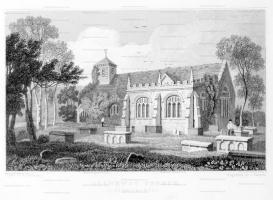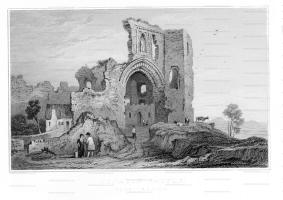Text this colour links to Pages. Text this colour links to Family Trees. Text this colour are links that are disabled for Guests.
Place the mouse over images to see a larger image. Click on paintings to see the painter's Biography Page. Mouse over links for a preview. Move the mouse off the painting or link to close the popup.
All About History Books
The Deeds of King Henry V, or in Latin Henrici Quinti, Angliæ Regis, Gesta, is a first-hand account of the Agincourt Campaign, and subsequent events to his death in 1422. The author of the first part was a Chaplain in King Henry's retinue who was present from King Henry's departure at Southampton in 1415, at the siege of Harfleur, the battle of Agincourt, and the celebrations on King Henry's return to London. The second part, by another writer, relates the events that took place including the negotiations at Troye, Henry's marriage and his death in 1422.
Available at Amazon as eBook or Paperback.
Wales Illustrated North Wales is in Wales Illustrated.

Llanrwst Bridge [Map] And Church.
Llanrwst is a small town, pleasantly situated on the river Conway, in Denbighshire, and though but a small place, it monopolises the chief trade of the surrounding district. The bridge [Llanrwst Bridge, Clywd [Map]] is considered the principal object worthy of notice, having been built after a design by the celebrated Inigo Jones, who is said to have been a native of the place, and who also furnished the design for the chapel, adjoining the church. Though not magnificent, the bridge is certainly a handsome structure, and displays somewhat of the genius of its farfamed architect. It was built by an order from the privy council, in the 9th year of Charles the first; the expense, estimated at one thousand pounds, being conjointly defrayed by the counties it connects — Caernarvon and Denbigh. It consists of three arches, the central one the largest, measuring nearly sixty feet in the span; — it is asserted that this bridge is formed upon such nice principles, that when a person pushes against the large stone placed over the middle arch, the whole fabric may be felt to vibrate. The scenery, both above and below, is enchanting; gratifying the sight with the finest objects, grouped in endless variety. The hills and woods, which line both margins of the river, are enlivened by the busy display of small vessels on its surface, going to and from Triefrew, a village about two miles down, and the highest point to which the tide flows; or with still more diminutive coracles, fishing for salmon and smelts. Less extended than the vale of Clwyd, and wider than that of Llangollen, the vale of Llanrwst has often been admired, as exhibiting the most variegated assemblage of beauty; it has been the subject of eulogium of that competent judge, both of the sublime and beautiful, Mr. Burke, who pronounced it, "the most charming spot he had seen in Wales." This place was famous for the manufacture of Welsh harps; but in 1810, the harp makers had become extinct, no one carrying on that business, and the instrument becoming scarce, rose in price; those, by the best makers, fetching twenty-five guineas.
![]() Become a Member via our Buy Me a Coffee page to read complete text.
Become a Member via our Buy Me a Coffee page to read complete text.

The ancient mansion built by John Wynne ap Meredydd is an extensive pile of buildings, without much regularity, ranged in the quadrangular style, comprising an inner and outer court. Immediately beyond the house, the ground rises very rapidly, to the foot of the perpendicular cliffs, forming the west boundary of the valley, all which space is now occupied by a fine wood, in the highest luxuriance of growth that can be imagined, while the summit of the rocks is also adorned with all the variety of foliage. Half way up is an irregular plain, containing a few cottages, the remains of a magnificent terrace, and a handsome domestic chapel, built in the gothic style, and overshadowed by a large Spanish chesnut-tree. Climbing to the tops of the cliff which overlook this lovely scene, you are gratified with a view over the rich broad vale of Llanrwst, watered by the windings of the Conway, covered with meadows and corn fields, and enlivened by villages and seats peeping from among the sheltering woods, which clothe the higher and bleaker parts of the valley. Many beautiful and romantic cataracts may be seen in the vicinity; and whoever visits Wales, should not fail to see the admired vale of Llanrwst.

Great Gatehouse [Map] at Denbigh Castle.